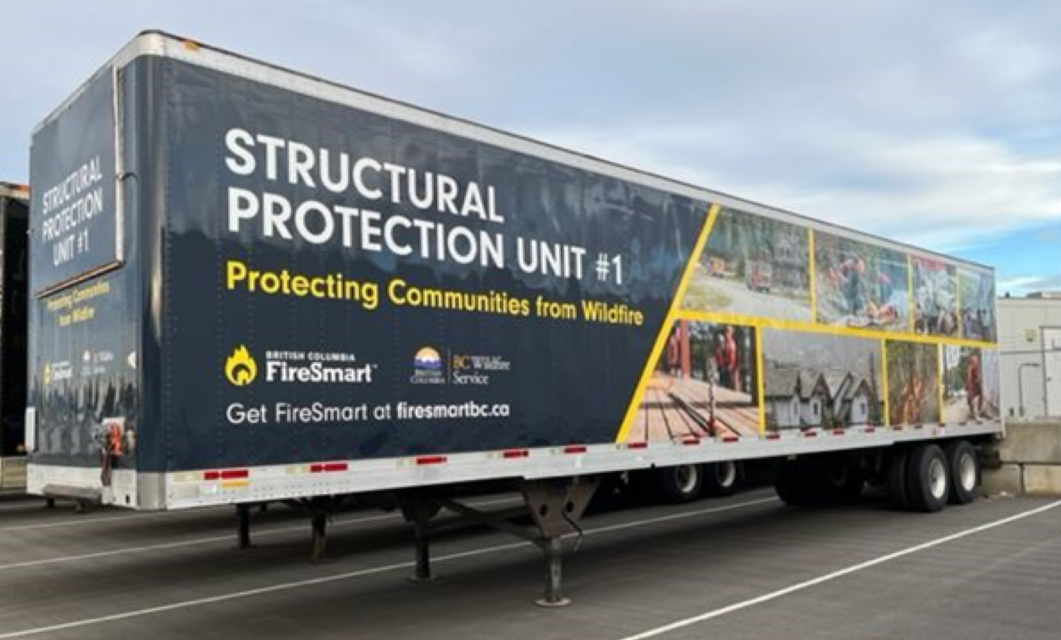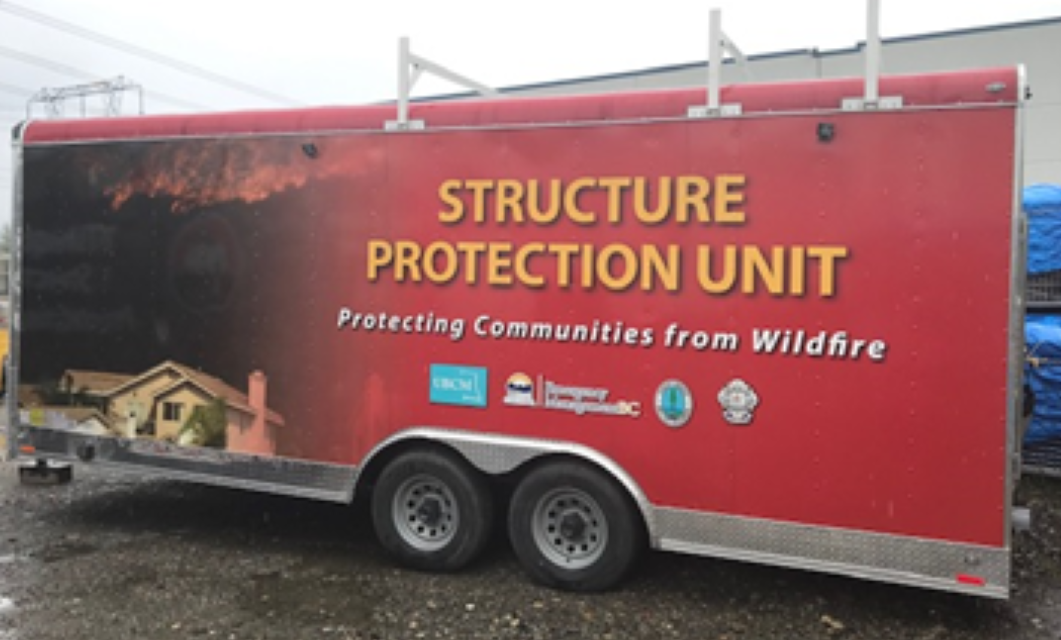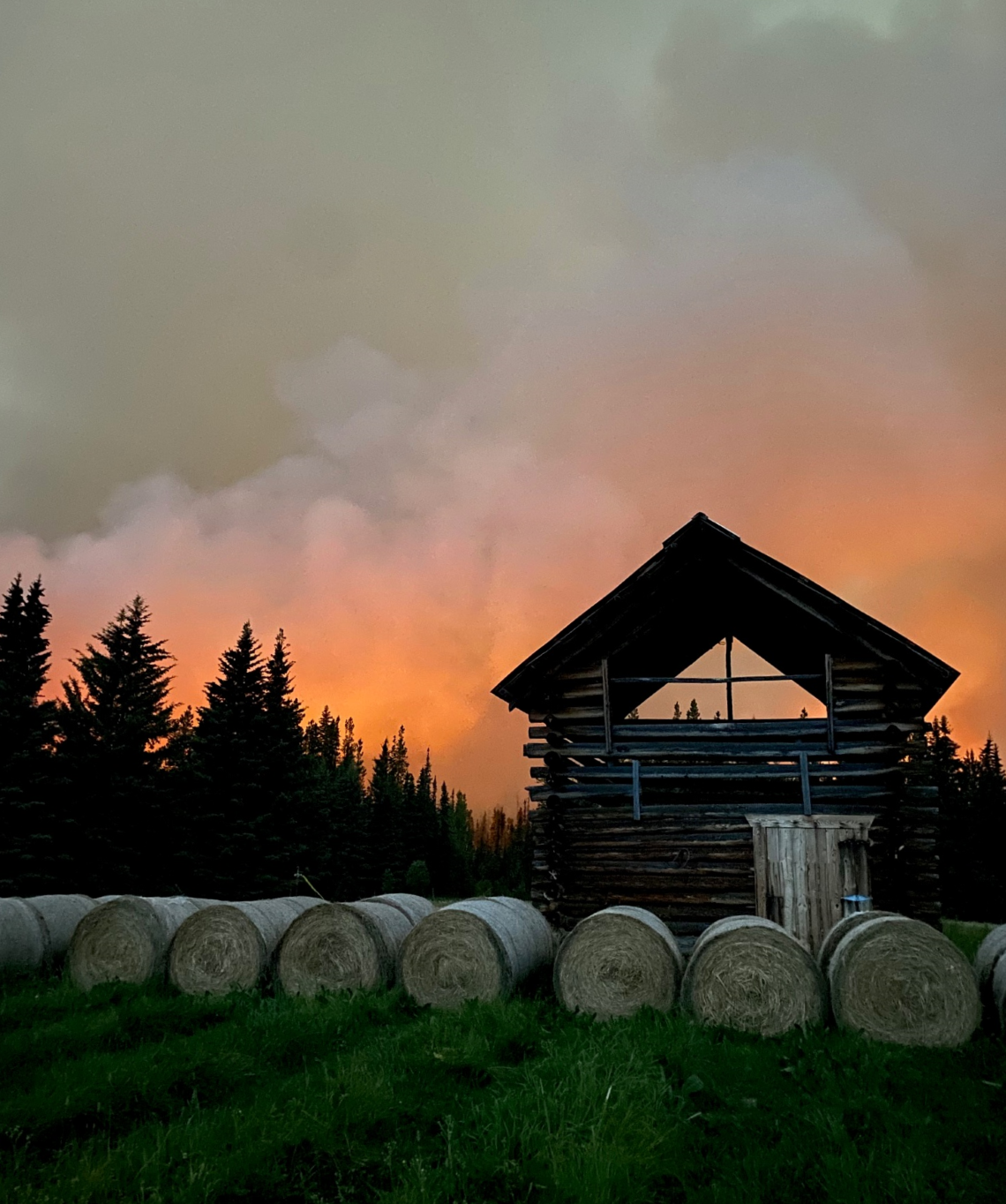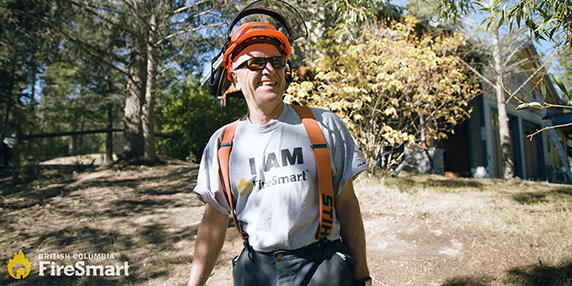Structure protection
Wildland firefighting crews are not equipped or trained to deal with structural fires so must work with structure protection personnel, whose function is to protect and mitigate structures that may be threatened by wildfire.
Interface and intermix fires are becoming more prevalent across British Columbia.
Learn more about what you can do to increase the resiliency of your home and property from wildfire.
Structure protection specialists
Structure protection specialists (SPS) have the tools and training to defend properties that may be threatened by wildfire by performing the following activities
- Plan and oversee structure protection tactics and activities
- Carry out mitigation and action plans using structural protection techniques and equipmet
- Conduct fuel management operations
- Identify critical priority objectives
Structure protection units
Structure protection units (SPU) are trailers used by SPS across the province. They contain pertinent equipment such as pumps, hoses, sprinklers and water delivery attachments for defending structures and other sites against wildfires. The BC Wildfire service owns and operates eight SPU that are strategically placed throughout the province. During wildfire season, the BC Wildfire Service also has access to more than 40 trailers through contractors and local fire departments.
There are two types of SPU. Type 1 SPU hold a large amount of equipment, usually enough to defend around 125 structures. Type 2 SPU can either be owned by the BC Wildfire Service, contractors or other fire departments. They hold enough equipment to complete around five structures.
 Type 1 SPU
Type 1 SPU
 Type 2 SPU
Type 2 SPU
Structure protection tactics
The BC Wildfire Service uses a variety of structure protection tactics when defending buildings or other sites from wildfire. The most common tactic is to create “humidity bubble” around the structure using strategically placed sprinklers. This tactic aims to increase the relative humidity surrounding the structure thereby decreasing the chances for embers and burning debris to ignite on or around it. Crews may also establish wet lines around properties to slow or stop advancing wildfire.
Choosing which structure protection tactics to deploy depends on the behaviour of the approaching wildfire as well as the properties and structures requiring protection. Residents can help increase the defensibility of their home by applying scientifically proven FireSmart practices to their property.

Frequently asked questions
Why can’t BC Wildfire Service wildland firefighters attend building or vehicle fires?
The BC Wildfire Service is mandated to fight wildfires, which predominantly consists of burning trees and other vegetation. Wildland firefighters are not trained nor equipped to respond to fires involving non-organic materials. These structural fires produce hazards including noxious smoke that crews cannot attend to safely.
What does the BC Wildfire Service do when wildfire threatens a structure?
When a wildfire threatens a structure, the BC Wildfire will deploy a structure protection specialist (SPS) to assess the situation and order more resources if necessary. These resources can include fire engines, tenders, Type 1 & 2 structure protection units (SPU) and structure suppression crews (SPC).
How does the BC Wildfire Service decide when and where to deploy structure protection resources?
A structure protection coordination officer (SPCO) oversees triaging structure protection resources across the province. The SPCO determines where structure protection equipment and personnel will be deployed by assessing several factors. Some of these factors include fire behavior, availability of resources and whether there is a threat to human life and property.
Where are structure protection units (SPU) based at the start of wildfire season?
All Type 1 SPU are initially stocked out of the Provincial Equipment Depot located in Chilliwack. Type 2 SPU are located in both Chilliwack and Kamloops as well as dispersed throughout the province with contractors and fire departments. When the wildfire season begins, the BC Wildfire Service will strategically position their Type 1 & 2 SPU throughout the province in areas most at risk or threatened by wildfire.
Why might structure protection be removed from a property after it was deployed there?
Structure protection equipment and personnel may be repositioned if there is a higher risk to human life or property elsewhere. Other influential factors include fire behaviour and availability of resources.
What’s the difference between BC Wildfire Service structure protection and other fire departments?
Structure protection is a program embedded within the BC Wildfire Service that strategically organizes structure protection response within the province when critical infrastructure and residences are threatened by wildfire. Fire departments provide the structure protection apparatus (i.e. engines, tenders, units and other equipment) as well as specialized personnel that are trained and equipped to respond to structure fires resulting from wildfire.
With a few simple steps you can contribute to increasing your property, neighbourhood and community resiliency to wildfire. Learn more.
Each year, updated information packages are sent to all municipal and regional fire departments in B.C. asking for expressions of interest to participate in the structure protection program. Learn more about how to get involved.

